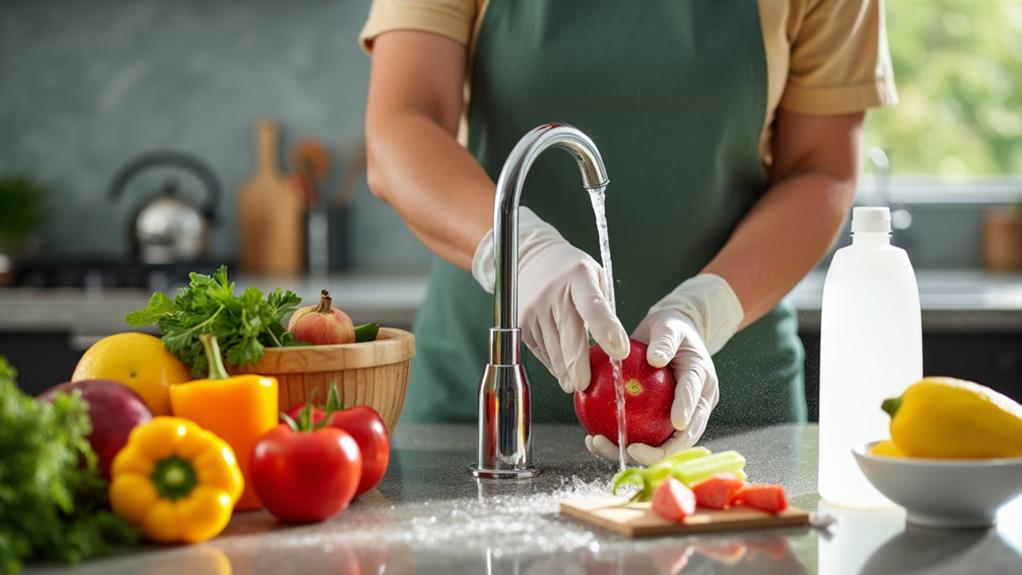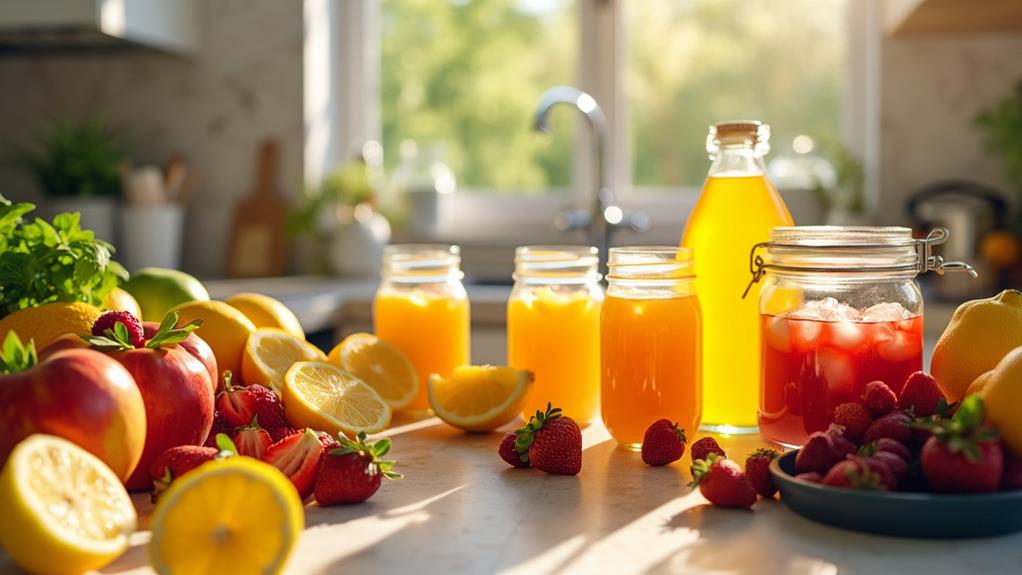Signs Your Juice Has Spoiled
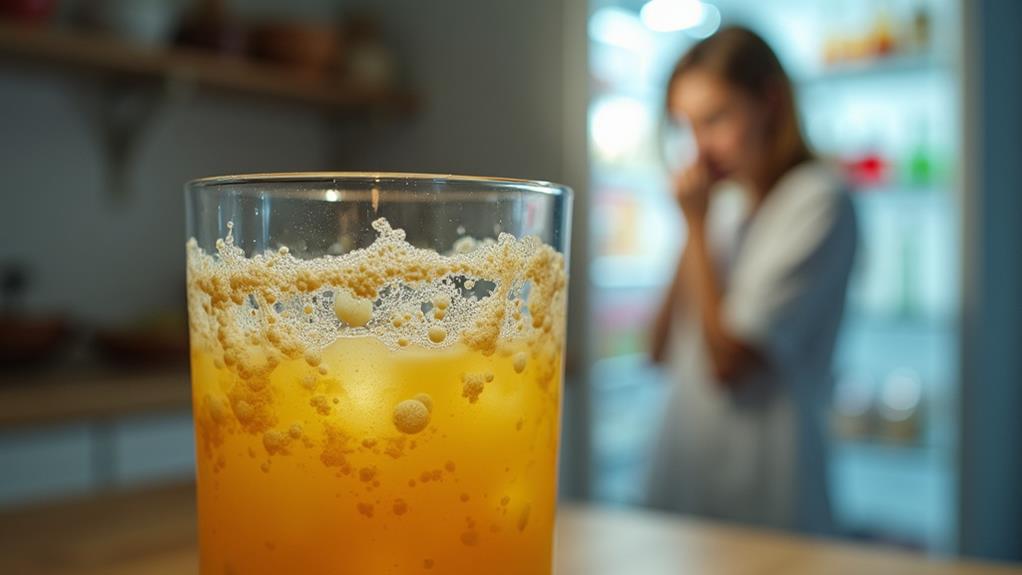
Juice may seem like a straightforward beverage, but recognizing the signs of spoilage is crucial for ensuring its safety. A change in color from a vibrant hue to a murky or dull shade is a major warning. An off-putting smell also signals that the juice has gone bad. Texture changes, such as chunkiness or sliminess, are clear indicators of spoilage. Additionally, bloated packaging and sediment accumulation are significant signs to watch for. Understanding these indicators helps you handle spoiled juice effectively. Let's delve deeper into these signs and learn how to manage them properly.
Color Changes
One of the initial signs your juice has spoiled is a change in color. Fresh, cold-pressed juice should have a vibrant hue, indicating its freshness and high nutritional value. However, when the juice's color shifts to a murky or dull appearance, it strongly suggests spoilage. Oxidation often causes juice to transition from its original bright color to a grayish or brownish tint, signaling a decline in both quality and nutritional value.
If you observe sediment or separation, this can also indicate the beginning stages of spoilage, typically accompanied by a noticeable color change. A paler or darker than normal appearance may signal degradation or the development of harmful bacteria, both of which are serious signs of spoilage.
It's crucial to avoid consuming juice that has experienced these color changes, as it not only suggests the juice has gone bad but also poses potential risks for foodborne illnesses. Always monitor the color of your juice to identify spoilage early and ensure you consume it while it is still safe and nutritious.
Unpleasant Odor
If your juice smells sour, fermented, or has an unpleasant odor, it indicates spoilage. Fresh juice should have a fruity and pleasant aroma; any deviation from this suggests that it is no longer safe to drink and should be discarded.
Sour or Fermented Smell
A sour or fermented smell in your juice strongly indicates spoilage. This odor typically results from over-fermentation, which not only alters the taste but also suggests the presence of harmful bacteria, making the juice unsafe to drink. Fermentation can occur rapidly, especially in cold-pressed juices rich in natural sugars and lacking preservatives.
| Indicator | Meaning | Action to Take |
|---|---|---|
| Sour Smell | Over-Fermentation | Discard the juice |
| Vinegar-like Odor | Clear Sign of Spoilage | Do not consume |
| Color Change | Additional Spoilage Sign | Confirm spoilage, discard |
| Texture Alteration | Confirms Fermentation | Unsafe, discard immediately |
If your juice emits a vinegar-like odor, it is clearly spoiled. This strong smell is a definitive sign of significant fermentation. When combined with color changes or texture alterations, the sour smell confirms that the juice is no longer safe for consumption. Always err on the side of caution and discard any juice with an unpleasant odor to avoid the risk of foodborne illness. Monitoring these signs ensures you only consume fresh, safe juice.
Rancid or Off-Putting Aroma
A rancid or off-putting aroma in juice strongly indicates spoilage, often due to harmful bacteria. Fresh juices typically have a pleasant, lively scent, whereas spoiled juice may emit strong, fermented, or vinegar-like odors. These smells signify fermentation, making the juice unsafe to consume.
If you notice a sour or unpleasant aroma, it's crucial to take it seriously. This often accompanies other spoilage signs like color changes or a chunky texture, confirming the juice should be discarded. Unlike other foods where tasting might be an option, tasting spoiled juice is not recommended. The odor alone serves as a sufficient warning.
Your sense of smell is a reliable tool for determining juice safety. If the aroma is rancid or off-putting, dispose of the product to avoid any health risks. Trust your nose; it's better to be cautious with potential spoilage.
Texture Alterations
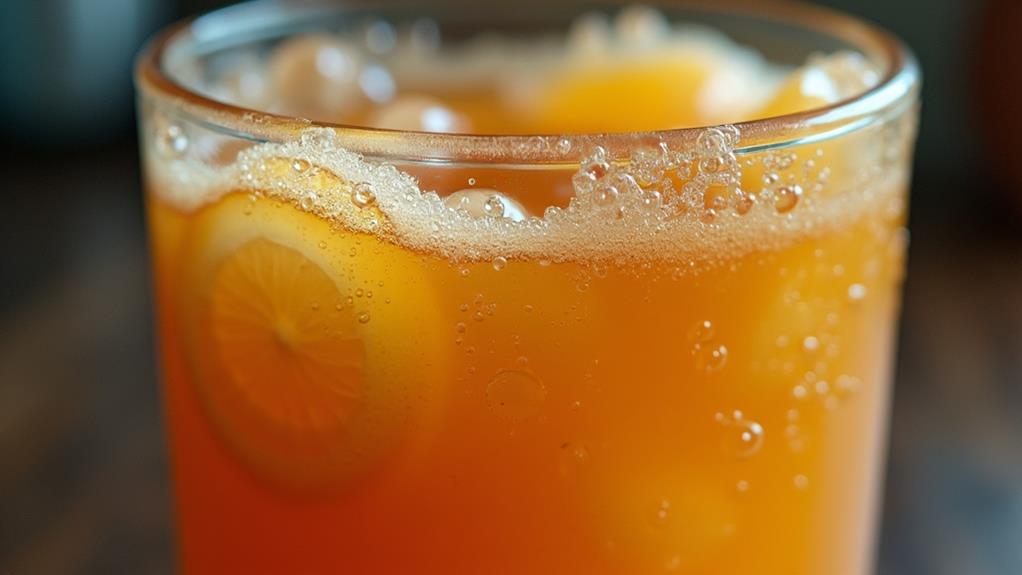
When your juice exhibits a chunky or slimy texture, it's a clear indication of spoilage. Fresh juice should have a smooth consistency without any lumps or sediment. These texture changes suggest that your juice is no longer safe to drink.
Here are the critical signs to watch for:
- Chunky: The presence of lumps in your juice signifies spoilage and makes it unsafe to consume.
- Slimy Consistency: A slimy texture strongly indicates contamination by bacteria or yeast.
- Thick, Gel-Like Consistency: If your juice has developed a thick, gel-like texture, it has likely over-fermented and should be discarded immediately.
- Sediment: Sediment at the bottom of the bottle can indicate separation and potential spoilage, especially if accompanied by a change in color or smell.
- Sticky Texture: An unusual sticky texture suggests microbial growth or fermentation, indicating that the juice is no longer fresh.
Always check for these texture alterations before consuming your juice. These changes can signal the presence of harmful bacteria and a loss of quality, making it crucial to be vigilant about your juice's condition.
Presence of Mold
Discovering mold on your juice is alarming and a clear sign it's unsafe to drink. Mold appears as white, green, or black fuzzy growth on the surface, indicating spoilage and harmful bacteria. If you see any mold, discard the entire container immediately. Even a small patch suggests mold spores may have spread throughout the juice, compromising its safety.
Mold growth usually results from improper storage conditions. Exposure to air, light, or temperatures above 40°F (4°C) can encourage mold to thrive. To minimize risk, always store juice in the refrigerator and ensure the container is tightly sealed. Mold can produce mycotoxins, posing serious health risks if ingested, especially for children, the elderly, and those with weakened immune systems.
To protect your health, regularly inspect your juice for signs of mold before consuming it. Mold presence indicates the juice should not be consumed. Don't take chances—your health is too important.
Bottle Bloatedness
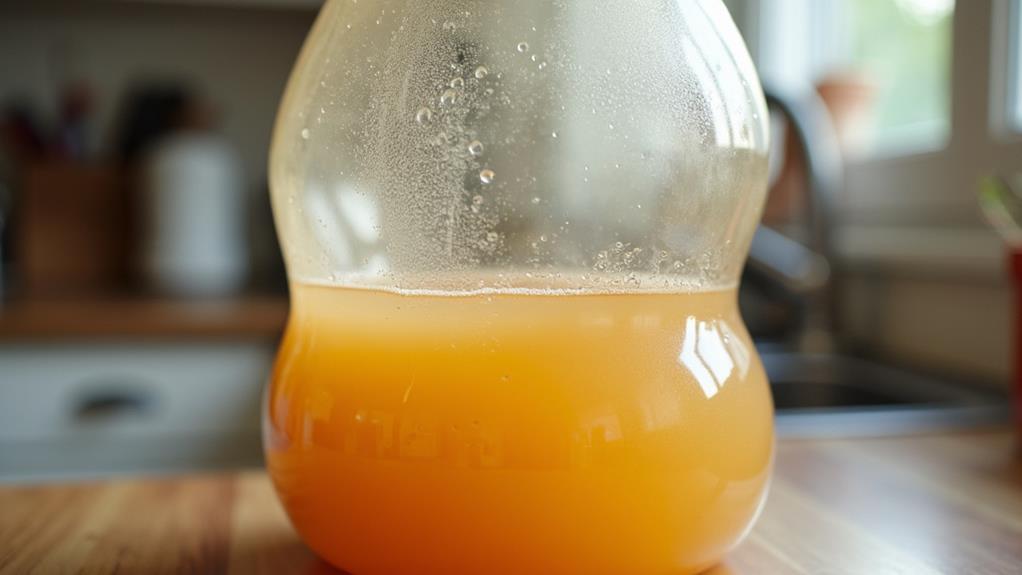
A bloated bottle is a clear indicator that your juice has spoiled and is unsafe to consume. When the packaging appears swollen or puffed out, it's a sign that gas buildup from fermentation has occurred, typically due to bacterial growth. Consuming such juice can lead to foodborne illnesses.
Before pouring yourself a glass, always check for any signs of bloatedness. This quick visual inspection can save you from potential health risks. If you find a bloated bottle, discard it immediately, even if the expiration date hasn't passed or the juice looks fine otherwise.
Key points to remember:
- Bloated bottles result from gas production due to bacterial activity.
- Bacterial growth in juice can cause serious health issues.
- Swollen packaging is a strong visual cue of spoilage.
- Discard a bloated bottle, regardless of the expiration date.
Sediment Accumulation
Noticing sediment accumulation in your juice is a strong indicator that it might be spoiled. Sediment often signifies the presence of harmful bacteria or fermentation byproducts. Freshly cold-pressed juice should have a uniform consistency, so any abnormal sedimentation is a red flag. While some natural pulp separation is normal, excessive or unusual sediment suggests the juice has likely gone bad.
Pay close attention to the appearance of the sediment. If it looks cloudy or has settled at the bottom of the container, discard the juice immediately. Consuming it could pose health risks, as spoiled juice can harbor harmful microorganisms that may cause illness. Sediment accumulation not only affects the juice's safety but also its flavor and texture, making it less enjoyable to drink.
To safeguard your health, always inspect your juice for any signs of spoilage, including sediment accumulation. If you notice anything unusual, err on the side of caution and discard the juice. Your health is far too crucial to take risks.
Unusual Taste
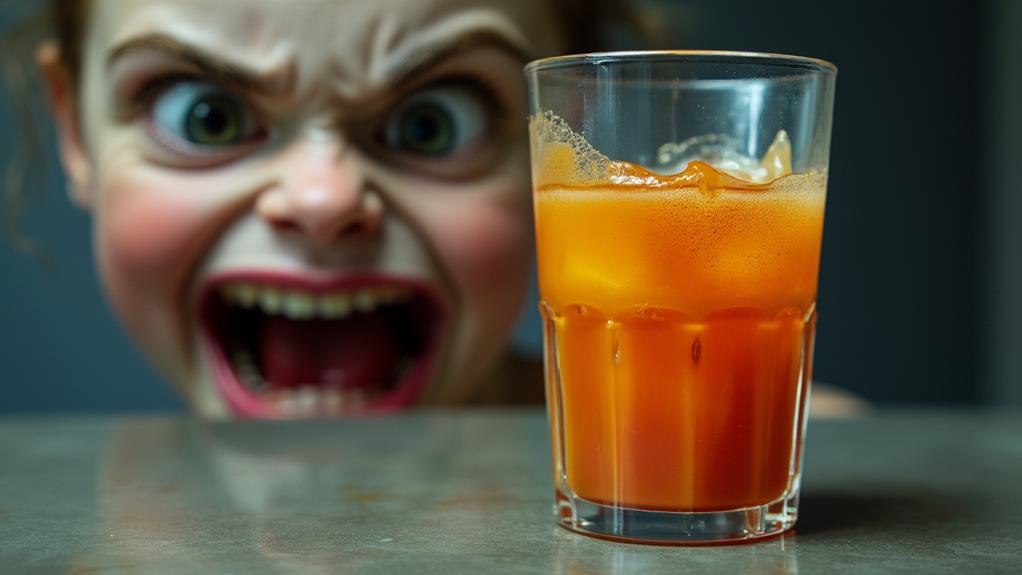
While sediment accumulation is a clear visual cue that your juice might be spoiled, an unusual taste is another significant indicator. Fresh juice should have a lively and invigorating flavor. If you notice any deviation from this, it's a red flag indicating potential spoilage due to over-fermentation or harmful bacteria. Trust your taste buds—they are your primary defense against consuming spoiled juice.
Specific tastes to watch out for include:
- Sourness: A common sign of spoilage, indicating fermentation.
- Off-flavor: Any taste that deviates from the original profile suggests degradation.
- Vinegar-like taste: A clear indicator that the juice has gone bad and should be discarded immediately.
- Bitterness: Fresh juice shouldn't taste bitter; if it does, it might be spoiled.
- Unpleasant flavor: Any strange or unpalatable taste is a signal that it's best not to consume the juice.
If your juice tastes different from its original flavor, it's likely no longer safe to drink. Always err on the side of caution and discard any juice that tastes unusual.
Expiration Dates
Understanding expiration dates on juice containers is crucial for maintaining your health. Always check the use-by dates and consume juices within the recommended time frame to prevent potential health risks. Recognizing the shelf life limits ensures your juice is safe and fresh.
Understanding Expiration Dates
Expiration dates on juice products are essential for ensuring both safety and flavor. These dates indicate the last day the juice is recommended for consumption based on quality assessments and testing. Knowing how long juice lasts and maintaining proper storage are key to keeping your juice fresh.
Store-bought juices, which are often pasteurized and contain preservatives, typically have a longer shelf life. They can stay fresh for 7-10 days after opening. To manage juice freshness effectively:
- Check expiration dates: Always look at the label before consuming juice.
- Track opening dates: Once opened, consume the juice within the specified timeframe.
- Proper storage: Keep your juice refrigerated to extend its freshness.
- Cold-pressed juices: These have a shorter shelf life, usually about 2-3 days due to the absence of preservatives.
- Sensory evaluation: For juices without clear expiration dates, rely on smell, taste, and appearance to determine freshness.
Importance of Use-By Dates
Use-by dates are crucial for ensuring your juice maintains its optimal quality and safety. These dates indicate the period during which the juice retains its peak flavor and nutritional value. Typically, store-bought juices have a shelf life of 7-10 days after opening if kept refrigerated. However, freshly squeezed or cold-pressed juices spoil more quickly, usually lasting only 2-3 days.
Recognizing Shelf Life Limits
Understanding the shelf life of juice is essential to avoid consuming spoiled products. Store-bought juices, often preserved with additives, can last 7-10 days after opening if stored properly. In contrast, cold-pressed juices have a much shorter shelf life, typically just 2-3 days when refrigerated.
Key points to remember:
- Expiration dates: Always check and adhere to expiration dates on store-bought juices to ensure safety.
- Proper storage: Refrigerate juices below 40°F (4°C) and use airtight containers to maintain freshness.
- Freshly pressed juices: Consume within 24 hours after thawing to prevent spoilage.
- Signs of spoilage: Discard juice if you notice off smells, color changes, or visible mold.
- Cold-pressed vs. store-bought: Cold-pressed juices spoil faster than store-bought ones due to the lack of preservatives.
Storage Conditions
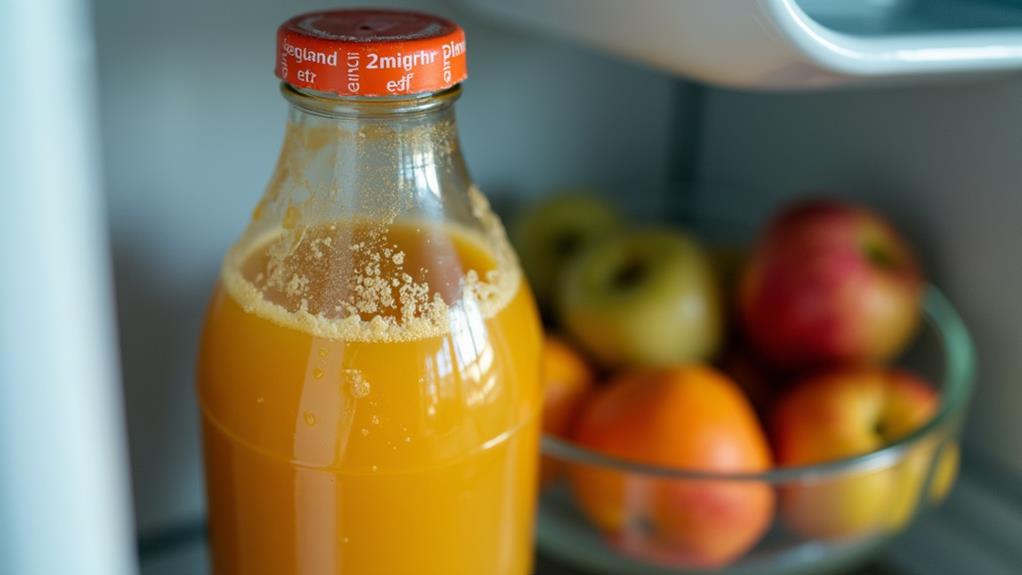
Proper storage conditions are essential for maintaining the freshness and safety of your cold-pressed juice. Always refrigerate your juice at temperatures below 40°F (4°C) to slow spoilage and extend its shelf life. Ideally, consume your freshly squeezed juice within 2 days if stored in the fridge, as its quality degrades rapidly beyond this point due to the lack of preservatives.
If your juice is not refrigerated, consume it within 8 hours. After this period, nutrient loss and bacterial growth become significant concerns. For instance, vitamin C levels can decline by 50% in just 8 hours at room temperature.
Freezing juice is another option to extend its shelf life. Store it in airtight containers to prevent moisture loss and oxidation, and it can last 6-12 months while retaining its nutritional integrity. Always keep your juices away from light and heat sources during storage to minimize oxidation and degradation. Following these storage tips will help ensure your juice remains fresh and safe to drink.

